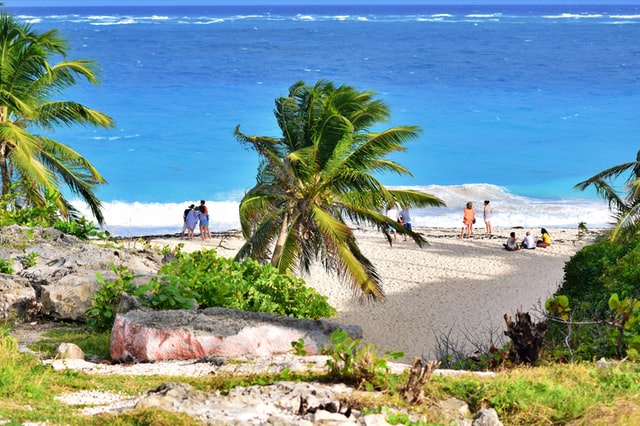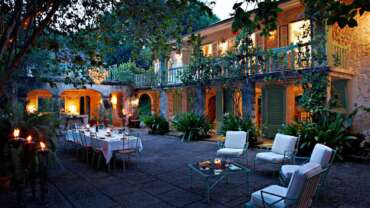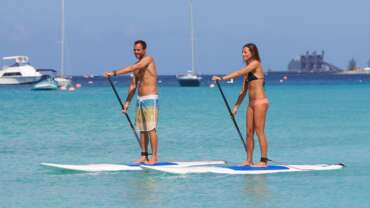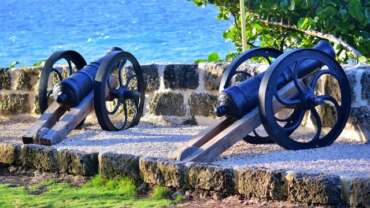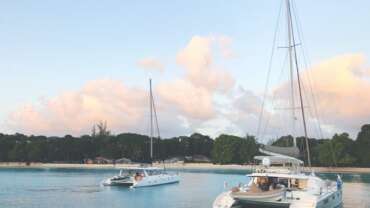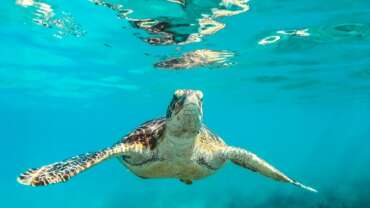Beaches in Barbados
Sit under a beach umbrella with a cool drink, find shade under a sea grape tree or jump right into the clearest, crystal water you could expect to find anywhere in the world!
A tropical locale is only as desirable as its coastline. And on this belief, Barbados never disappoints. Graciously endowed with more than 70 miles of sun-saturated, palm-adorned beaches, translucent azure waters and a year-round climate considered nothing less than perfect, the island is generous in giving Bajans and visitors alike a tropical respite unlike any in the world.
The island’s shores are as varied and unique as Barbados itself. The west coast offers calm waters and dusty white beaches on which you can unwind with a rum punch in hand. Along the eastern shoreline, impressive coral sculptures carved by incessant Atlantic trade winds and thunderous waves decorate an area long heralded as one of the best surfing spots in the world. To the south, flawless sands and reef-protected waters set the perfect scene for a day of snorkelling or swimming. Meanwhile the southeast coast entices those who seek adventure in its windsurfing playgrounds, and seduces couples with an alluring backdrop of sheer cliffs and fine pink sand.
Beach Facts
– Barbados boasts over 60 beaches across 70 square miles and offers more than 3000 hours of annual sunshine under which you can enjoy them all.
– Crane Beach in the parish of St. Philip has consistently been recognized as one of the Top 10 Beaches in the world.
– All beaches in Barbados are open to the public and access to them is considered a right of every Barbadian.
SEE WHY BARBADOS MAKES THE CUT FOR TOP BEACHES IN THE WORLD
Barbados is home to the finest beaches in the world. The Crane beach on the south eastern side of the island was rated by Lifestyles of the Rich and Famous as “one of the ten best beaches in the world”. And there are many more to experience around the island. You’ll notice immediately that the coastlines are different and the beaches themselves are as diverse as the people. Although you may have a preference, the myriad of choices makes Barbados a top pick for best beach holidays.
West Coast Beaches
With picture perfect, blue water and gold sand, west coast beaches have a reputation for creating idyllic days in the sun. The surf is gentle and small to medium waves make most beaches on the West Coast ideal for sunbathing and relaxation or, if you prefer, watersports, swimming and snorkelling.
South Coast Beaches
With small to medium waves, south coast beaches are mostly tailor-made for adventure and a range of watersports, including windsurfing, body surfing, kite surfing, scuba diving and snorkelling. You can really get wild on the south coast, as the surf is livelier than the west coast’s with more undertow than you’d expect, so don’t be caught off-guard.
East Coast Beaches
The east coast boasts a string of intriguing wind swept beaches, and due to pounding surf, large waves and strong currents, swimming is not recommended in most areas along this coastline. These beaches are nevertheless good spots for walking and sun bathing. Most of all, our east coast waves are favoured by surfers who come here from all over the world to test their skill at the famous Soup Bowl in Bathsheba.
North Coast Beaches
While you’re likely to encounter the occasional sheltered cove, there are not many beaches along this rugged coastline, where imposing coral and sandstone cliffs rise majestically from the sea, and weathered rocks serve as stunning exhibits in nature’s own art gallery. As you can imagine, the waves are large and the currents strong. Swimming is definitely NOT recommended.
But that’s not all there is, we’ve still got a number of hidden treasures to lay bare – secret bays, beaches and coves that we want to share with only YOU… Shhh…
Top hidden beaches in Barbados
These hidden treasures vary in size and seclusion and although some of them aren’t ideal for swimming, they are all top of the line for breathtaking photo opportunities, sunbathing and endless romantic walks. As tucked away and secluded as they might be, please bear in mind that there are no nude beaches in Barbados.
Freshwater Bay and Batts Rock Beach on the borders of St. Michael and St. James on the west coast form a gloriously tranquil coastline caressed by calm, clear water. There is some beach activity, surfing and lots of cosy spots for picnics.
Beachy Head Bay, Bottom Bay, Crane Beach, Foul Bay, Ginger Bay, Harrismith Beach / Cave Bay, Long Bay / Sam Lord’s Castle Beach, Palmetto Bay and Shark’s Hole Bay are all located on the southeast coast of St. Philip. Each of these is characterized by medium to large waves, undertow and strong currents.
Cotton House Bay, Freight’s Bay, Long Beach and Rescue Beach / Surfer’s Bay on the south coast of Christ Church are great for surfing and a day in the sun. With small to medium waves, there is lots of undertow and strong currents.
Cove Bay in the north offers spectacular views of our coastline at its most rugged and spectacular. Large waves and very strong currents make swimming hazardous, but you’ll be rewarded with the awesome photos you’ll be able to take back home.
No doubt, there is likely to be a beach to suit your every mood and fancy, but remember, seasonal weather can affect sea conditions, so you while you’re having fun, you still need to be careful.
BARBADOS BEACH GUIDE
Barbados is surrounded by over 70 miles of glorious palm-fringed, white sand beaches; warm, clear waters and a year round climate that is close to perfection.
Barbados law stipulates that all beaches are public so Barbadians and visitors therefore have no shortage of choice from the tranquil Caribbean Sea to the pounding surf of the Atlantic Ocean. Don’t forget to take along your sunscreen, and remember, topless sunbathing is against the law in Barbados.
West Coast
The sea on the west coast is idyllic for lazing, snorkelling and enjoying watersports like skiing. It’s also perfect for taking a stroll especially in the morning before the sun gets too hot.
Six Mens, Mullins, Gibbes and Reeds Bay
These beaches make up a magnificent stretch of beach in St. Peter with glassy, turquoise water, good snorkelling and a variety of watersports. Mullins Beach Bar offers service right to your beach chair and just a little further north there’s the new Bombas Beach Bar. Reeds Bay in Lower Carlton is a lovely, long crescent-shaped beach with easy access and great swimming.
Paynes Bay
Paynes Bay has a beautiful white sandy beach and the calm water is ideal for swimming and snorkelling with turtles, however, it can be crowded at times. There is a well-maintained public access between One Sandy Lane and Sandy Lane Hotel with limited roadside parking.
The Garden and Heron Bay
Between Royal Pavilion Hotel and Carlton in St. Peter is a lovely stretch of beach with several little paths through which you can gain access. For a delicious lunch there is the wonderful Lone Star or for an economical light bite or just a few drinks on the beach, Juju’s. Sometimes there are turtles around.
Holetown
Holetown has one main beach and a couple of small ones further south. Folkstone Marine Park and Museum, located just past Settlers Beach Hotel has a snorkelling trail and a small museum about the marine life in Barbados.
Batts Rock
Just past the northern end of Spring Garden Highway, there is a public access to this superb beach with parking, shade and great swimming.
Brighton Beach
The Cockspur Beach Club at Brighton Beach has beach chairs and umbrellas, lunch and drinks as well as loads of watersports. Caution – the area known as the ‘hot pot’, where warm water from the rum distillery flows, sometimes has dangerous currents.
South-east and East Coast
The south-east coast gets more breezy with slightly bigger waves – perfect for body surfing and boogie boards. The east coast welcomes the Atlantic rollers – Barbados has become world renowned for surfing.
Crane Beach
A truly stunning beach with excellent body-surfing conditions. There is a moderately challenging public access to the beach by the roundabout. You can pick up a picnic lunch nearby at Cutters of Barbados, a Bajan gourmet deli. Cold drinks are also sold on the beach. L’Azure Restaurant at The Crane Resort presents a spectacular view of the beach and serves food all day including a lovely afternoon tea. There is an elevator and steps down to the beach from the res ort. Boogie boards, chairs and refreshments.
Bottom Bay and Harrismith
Bottom Bay is everyone’s dream of the perfect tropical beach – cliffs, coconut palms, a cave, 50 ft white sand, brisk breezes and aquamarine sea. A first-class picnic venue!
Harrismith has much less beach area but does have a shallow lagoon for a calm dip at low tide and is also very beautiful. Both beaches have formidable steps. A handrail has been erected on the steps at Bottom Bay.
Foul Bay
This is a long, wide, open expanse of beach on a ruggedly attractive stretch of relatively undeveloped coastline. Care should be ta ken when swimming here as the waves are big and they break onshore – there can be a strong undertow at times. There are large shady areas suitable for picnics. No chair rentals or refreshments. Refreshments can be purchased at either Cutters of Barbados, a Bajan gourmet deli, The Palms Restaurant or the Texaco Gas Station – all nearby.
Bathsheba & Cattlewash
Although these two bays on the east coast are stunningly beautiful and the sea appears to be quite inviting, swimming is very dangerous with strong and unpredictable undercurrents and no lifeguards on duty. It is best just to take a dip at low tide in the rock pools. The Atlantis Hotel in Bathsheba, recently re-opened, serves tasty lunches and punches. There is a picnic spot with tables in Bathsheba with public facilities.
Bath
The sea here is very calm and is protected by a large reef. This is a popular picnic spot with Barbadians, especially on weekends and public holidays because there’s plenty of shade, a pleasant breeze, a small playground, a car park and brand new public facilities. There is a picturesque coastal footpath that runs from Bath to Martin’s Bay. It takes approximately an hour and a half to walk there and back. No chairs or refreshments.
South Coast
The south coast is a little more choppy and breezy with some beaches having small waves for boogie boarding. Around south point gets breezier with slightly bigger waves – perfect for the action-packed waterman sports – surfing, paddle-surfing, windsurfing and kitesurfing. You can try these – boards are available for rent, along with lessons from trained professionals.
Carlisle Bay
Over a mile of wide beach and calm waters, Carlisle Bay is a spectacular, crescent-shaped bay extending from Bridgetown to the Hilton Hotel. There is good snorkelling. Hazell’s Waterworld sells good quality snorkelling gear. This is an ideal bay for distance swimming and an informal group meets at the southern end on Saturdays at Sam. Pier to pier is approximately 1.2 km. Chairs, parking and refreshments.
Hastings
With the new south coast boardwalk it is now possible to walk from Accra for a couple of miles to Hastings. This is a marvellous stretch for rock pooling at low tide. There are several small beaches along the way for swimming.
Accra Beach
One of the most popular beaches on the island with parking, good swimming and trees for shade. It’s a great place for body-surfing and body-watching. Lifeguards are on duty. Shopping and supermarkets are also very close by.
Boogie boards, chairs and refreshments, showers, locally-made jewellery and souvenirs.
Miami Beach
A favourite south coast beach. Very calm on one side, while on the other it is choppy with small waves. Picnic facilities. Parking, chairs, refreshments, showers.
Dover and Sandy Beach
These are lovely expanses of beach with good swimming conditions on either side of St. Lawrence Gap. Sandy Beach is great for families with young children because of the shallow, calm water and picturesque lagoon. Chairs and refreshments.
Silver Sands
This is a lovely white sand beach with excellent conditions for windsurfing, wave-riding and kite-surfing. Many international windsurfing events are held here due to the ideal wind and wave conditions. DeAction Beach Shop, run by world-ranked Barbadian windsurfer Brian Talma, can be found near Silver Rock beach. They offer lessons and surfboards and windsurfing and kite-surfing equipment is also for sale or rental.
Be sure to have a colourful marker whenever you snorkel to alert watercraft of your presence.
THE BARBADOS SEA TURTLE
Two of the world’s rarest sea creatures make their nests on the beaches of Barbados . . . the Hawksbill and the Leatherback Turtles. The Hawksbill nests between April and November mainly on the west and south coasts of the island, whilst the mighty Leatherback, the largest of all turtle species, nests between February and July on the windswept beaches of the east coasts and south coasts. A long history of hunting of these animals for their meat, eggs and shells, has reduced Caribbean populations to fragments of their former size. There is currently a ban on turtle hunting in Barbados to allow population recovery of these endangered species. The Barbados Sea Turtle Project personnel carefully monitors the number of turtles making their nests on our island.
The Barbados Sea Turtle Project is based at the University of the West Indies, Cave Hill Campus. The Project provides a 24-hour Sea Turtle Hotline (230-0142) year round which the public and visitors can use to call in information on turtles nesting, hatching of eggs, or lost or injured turtles. Project staff is called on to relocate nests made too close to the high tide line, to rescue hatchlings disoriented by hotel lights, and to rehabilitate turtles that have been accidentally hooked or partially drowned in fishing nets. In addition, Project staff patrol high-density nesting beaches nightly during the height of the nesting season, measuring and tagging nesting females and recording nest locations. This action allows information to be gathered that will determine if the Project’s conservation efforts are beginning to recover populations and serves as a deterrent to would-be poachers.
Adult turtles return to the beaches that they themselves hatched on 20-30 years previously, in order to make their own nests. These marine reptiles emerge from the water every 2-5 years and make 4-6 nests for the season. Where they locate their eggs is important, for sea-water kills the developing embryos. Furthermore, the sex of embryos is determined by sand temperature . . . cool temperatures found closer to the tide line produce males and warm temperatures produce females.
Between nesting seasons, these magnificent creatures undergo long migrations back to their feeding grounds. For instance, Barbados’ nesting Hawksbills forage in countries as far flung as Dominica and Venezuela. Our leatherbacks likely go even further afield, feeding in the productive waters of the North and East Atlantic.
Sea turtles are fascinating animals and an important natural resource for Barbados. Once considered important only for their meat, eggs and shells, the value of populations of sea turtles to Barbados’ eco-tourism industry is now being recognised. For instance, green turtles can be viewed by snorkellers close to shore at Mount Standfast near the Lone Star Restaurant. This is an initiative of the local fisherfolk community at Mount
Standfast and is testament to changing views about the value of sea turtles within the fishing community. Many of the local sailing cruises make regular visits to this bay where visitors can swim and mingle with these gentle creatures. Children find this especially fascinating and often refer to their visit with the turtles as the highlight of their holiday.
At the request of the Government of Barbados, the Barbados Sea Turtle Project monitors the impact of this daily traffic on the green turtles. The contribution that sea turtles make to the health of our reefs is also now being appreciated.
Hawksbills feed almost exclusively on sponges associated with coral reefs, one of very few vertebrates that can cope with such an indigestible diet! They can therefore play an important role in controlling growth of sponges, and prevent sponges from out-competing corals for space on the reef. Nesting Hawksbill Sea Turtles can be readily seen on our beaches, but are easily disturbed whilst nesting. Care should be taken if you are lucky enough to spot one on the beach. Call the Sea Turtle Hotline and the Project’s trained personnel will come to the beach to record the nesting event and take data on the female. They will be happy to share their information with you. Additionally, you can call the Hotline if you are interested in witnessing the release of turtle hatchlings.



